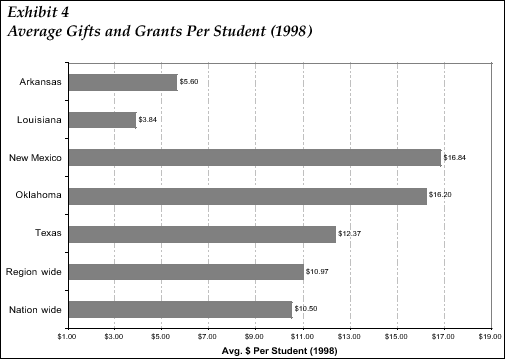|
Nationally, schools received an estimated $10.50 per student in philanthropic gifts and grants in
1997-98 (Exhibit 4); the Southwestern Region estimate is just slightly higher at $10.97 per
student. However, that close-to-average performance regionally was composed of wide
variances among the five states, New Mexico and Oklahoma each reported more than $16 per
student, with Arkansas showing an estimate of only $5.60 and Louisiana reporting only
$3.84 per student. Texas was closest to the national and regional averages at $12.37.

In absolute dollars, the region attracted some $68.6 million in philanthropic support in 1998-99, with 71 percent of that going to schools in Texas, outpacing Texas' 64 percent of the region's total student enrollment. On the other hand, Texas' share of the total dollars was remarkably close to its share of the region's districts ranked among the nation's 100 largest (14 out of 19 in the region, or 73 percent).
Recognizing that their states lag behind regional and national averages for philanthropic support of public schools, the state school chiefs in Arkansas and Louisiana have joined a four-state coalition seeking more money for education from private and federal sources. (Galley, 2000). The unprecedented effort, which also includes state school leaders in Alabama and Mississippi, intends to focus on proposals to Congress, foundations, and private philanthropists early in 2001. Their hope is that a regional approach will give them an advantage with funding sources that favor programs that cross state boundaries.
Within states, philanthropic support appears to gravitate toward the larger districts with the resources to hire grant writers, and/or districts located closer to the private foundations and corporations that make grants. Some of this may result from the visibility of close-to-home projects, but many donors also have charters that restrict their giving to certain geographic areas. Whatever the reason, concentration of gifts in large cities is the most obvious disparity in the distribution of philanthropic largess. In Louisiana, for example, 79 percent of the philanthropic support received by public schools in 1998-99 went to just six (9 percent) of the state's parishes, with East Baton Rouge dominating the field. In New Mexico, 90 percent went to nine districts (10 percent), Albuquerque and Santa Fe were among the largest beneficiaries. In Oklahoma it was 58 percent to 10 districts (2 percent), most of that going to districts in the Tulsa and greater Oklahoma City area. And in Texas it was 72 percent to 10 districts (or 0.1 percent), predominantly districts in the greater Houston area, Plano, Dallas and Fort Worth. (District-level data are not available for Arkansas.) Appendix A provides a listing of philanthropic revenues for the most successful districts in each state during 1998-99.
|